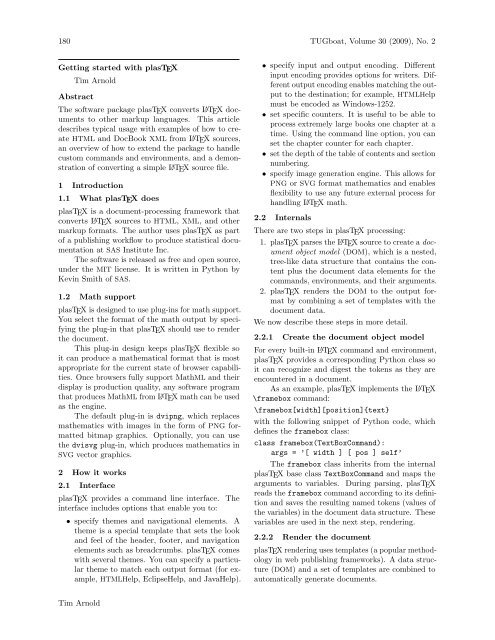The Communications of the TEX Users Group Volume 30 ... - TUG
The Communications of the TEX Users Group Volume 30 ... - TUG
The Communications of the TEX Users Group Volume 30 ... - TUG
You also want an ePaper? Increase the reach of your titles
YUMPU automatically turns print PDFs into web optimized ePapers that Google loves.
180 <strong>TUG</strong>boat, <strong>Volume</strong> <strong>30</strong> (2009), No. 2<br />
Getting started with plas<strong>TEX</strong><br />
Tim Arnold<br />
Abstract<br />
<strong>The</strong> s<strong>of</strong>tware package plas<strong>TEX</strong> converts L A<strong>TEX</strong> documents<br />
to o<strong>the</strong>r markup languages. This article<br />
describes typical usage with examples <strong>of</strong> how to create<br />
HTML and DocBook XML from L A<strong>TEX</strong> sources,<br />
an overview <strong>of</strong> how to extend <strong>the</strong> package to handle<br />
custom commands and environments, and a demonstration<br />
<strong>of</strong> converting a simple L A<strong>TEX</strong> source file.<br />
1 Introduction<br />
1.1 What plas<strong>TEX</strong> does<br />
plas<strong>TEX</strong> is a document-processing framework that<br />
converts L A<strong>TEX</strong> sources to HTML, XML, and o<strong>the</strong>r<br />
markup formats. <strong>The</strong> author uses plas<strong>TEX</strong> as part<br />
<strong>of</strong> a publishing workflow to produce statistical documentation<br />
at SAS Institute Inc.<br />
<strong>The</strong> s<strong>of</strong>tware is released as free and open source,<br />
under <strong>the</strong> MIT license. It is written in Python by<br />
Kevin Smith <strong>of</strong> SAS.<br />
1.2 Math support<br />
plas<strong>TEX</strong> is designed to use plug-ins for math support.<br />
You select <strong>the</strong> format <strong>of</strong> <strong>the</strong> math output by specifying<br />
<strong>the</strong> plug-in that plas<strong>TEX</strong> should use to render<br />
<strong>the</strong> document.<br />
This plug-in design keeps plas<strong>TEX</strong> flexible so<br />
it can produce a ma<strong>the</strong>matical format that is most<br />
appropriate for <strong>the</strong> current state <strong>of</strong> browser capabilities.<br />
Once browsers fully support MathML and <strong>the</strong>ir<br />
display is production quality, any s<strong>of</strong>tware program<br />
that produces MathML from L A<strong>TEX</strong> math can be used<br />
as <strong>the</strong> engine.<br />
<strong>The</strong> default plug-in is dvipng, which replaces<br />
ma<strong>the</strong>matics with images in <strong>the</strong> form <strong>of</strong> PNG formatted<br />
bitmap graphics. Optionally, you can use<br />
<strong>the</strong> dvisvg plug-in, which produces ma<strong>the</strong>matics in<br />
SVG vector graphics.<br />
2 How it works<br />
2.1 Interface<br />
plas<strong>TEX</strong> provides a command line interface. <strong>The</strong><br />
interface includes options that enable you to:<br />
• specify <strong>the</strong>mes and navigational elements. A<br />
<strong>the</strong>me is a special template that sets <strong>the</strong> look<br />
and feel <strong>of</strong> <strong>the</strong> header, footer, and navigation<br />
elements such as breadcrumbs. plas<strong>TEX</strong> comes<br />
with several <strong>the</strong>mes. You can specify a particular<br />
<strong>the</strong>me to match each output format (for example,<br />
HTMLHelp, EclipseHelp, and JavaHelp).<br />
Tim Arnold<br />
• specify input and output encoding. Different<br />
input encoding provides options for writers. Differentoutputencodingenablesmatching<strong>the</strong>output<br />
to <strong>the</strong> destination; for example, HTMLHelp<br />
must be encoded as Windows-1252.<br />
• set specific counters. It is useful to be able to<br />
process extremely large books one chapter at a<br />
time. Using <strong>the</strong> command line option, you can<br />
set <strong>the</strong> chapter counter for each chapter.<br />
• set <strong>the</strong> depth <strong>of</strong> <strong>the</strong> table <strong>of</strong> contents and section<br />
numbering.<br />
• specify image generation engine. This allows for<br />
PNG or SVG format ma<strong>the</strong>matics and enables<br />
flexibility to use any future external process for<br />
handling L A<strong>TEX</strong> math.<br />
2.2 Internals<br />
<strong>The</strong>re are two steps in plas<strong>TEX</strong> processing:<br />
1. plas<strong>TEX</strong> parses <strong>the</strong> L A<strong>TEX</strong> source to create a document<br />
object model (DOM), which is a nested,<br />
tree-like data structure that contains <strong>the</strong> content<br />
plus <strong>the</strong> document data elements for <strong>the</strong><br />
commands, environments, and <strong>the</strong>ir arguments.<br />
2. plas<strong>TEX</strong> renders <strong>the</strong> DOM to <strong>the</strong> output format<br />
by combining a set <strong>of</strong> templates with <strong>the</strong><br />
document data.<br />
We now describe <strong>the</strong>se steps in more detail.<br />
2.2.1 Create <strong>the</strong> document object model<br />
For every built-in L A<strong>TEX</strong> command and environment,<br />
plas<strong>TEX</strong> provides a corresponding Python class so<br />
it can recognize and digest <strong>the</strong> tokens as <strong>the</strong>y are<br />
encountered in a document.<br />
As an example, plas<strong>TEX</strong> implements <strong>the</strong> L A<strong>TEX</strong><br />
\framebox command:<br />
\framebox[width][position]{text}<br />
with <strong>the</strong> following snippet <strong>of</strong> Python code, which<br />
defines <strong>the</strong> framebox class:<br />
class framebox(TextBoxCommand):<br />
args = ’[ width ] [ pos ] self’<br />
<strong>The</strong> framebox class inherits from <strong>the</strong> internal<br />
plas<strong>TEX</strong> base class TextBoxCommand and maps <strong>the</strong><br />
arguments to variables. During parsing, plas<strong>TEX</strong><br />
reads <strong>the</strong> framebox command according to its definition<br />
and saves <strong>the</strong> resulting named tokens (values <strong>of</strong><br />
<strong>the</strong> variables) in <strong>the</strong> document data structure. <strong>The</strong>se<br />
variables are used in <strong>the</strong> next step, rendering.<br />
2.2.2 Render <strong>the</strong> document<br />
plas<strong>TEX</strong> rendering uses templates (a popular methodology<br />
in web publishing frameworks). A data structure<br />
(DOM) and a set <strong>of</strong> templates are combined to<br />
automatically generate documents.

















